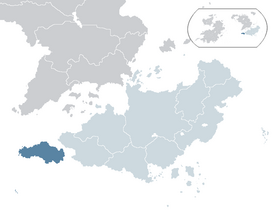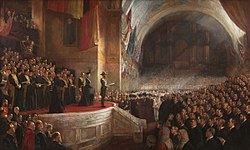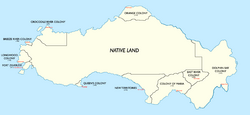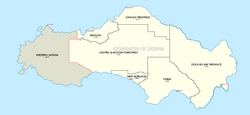The Depression Club
Satavian Federation | |
|---|---|
| Anthem: "I Heard My Country Calling" | |
 | |
 | |
| Capital and largest city | Port Hope |
| Official languages | Estmerish |
| Recognised national languages | Asteriaans Hennish |
| Demonym(s) | Satavian |
| Government | Federal parliamentary constitutional republic |
| Jago Elliot | |
| Arthur Warwick | |
| Legislature | Parliament of Satavia |
| Senate | |
| House of Representatives | |
| Independence from Estmere | |
• Federation and Constitution | 1 October 1816 |
| 23 September 1936 | |
| 17 December 1976 | |
| Area | |
• Total | 600,105 km2 (231,702 sq mi) |
| Population | |
• 2022 census | 24,581,912 |
• Density | 40.96/km2 (106.1/sq mi) |
| GDP (PPP) | 2022 estimate |
• Total | $719 billion |
• Per capita | $29,250 |
| GDP (nominal) | 2022 estimate |
• Total | $479 billion |
• Per capita | $19,500 |
| Gini (2018) | medium |
| HDI (2018) | very high |
| Currency | Satavian guilder (SVG) |
| Time zone | UTC+ 11 (Satavian Standard Time) |
| Date format | dd.mm.yyyy |
| Driving side | right |
| Calling code | +51 |
| Internet TLD | .sv |
Satavia, officially the Satavian Federation, is an island country in western Asteria Inferior comprising the island of Satavia and several outlying islands. Satavia shares a maritime border with Nuvania across the Van Horn Strait. Satavia is the smallest country in Asteria Inferior by land area and third smallest by population, but maintains the highest GDP per capita and living standards on the continent. Satavia is a federal parliamentary constitutional republic, consisting of six provinces, two territories and one dependent territory in free association with Satavia, the Patrick Islands.[N 1] Satavia's capital, largest city and primary economic centre is Port Hope, whilst other major cities include Burnaby, Fort Dent, Northport, Port Arthur and Victoriaburg.
The first human habitation of the island began some 38,000 years ago, and they are the ancestors of modern Indigenous Satavians. Despite the advancements of neighbouring indigenous peoples in Asteria Inferior, native groups within Satavia remained relatively primitive, avoiding contact with other tribal groups such as those in Nuvania, but nonetheless lived in general harmony with one another. Satavia is believed to have been first discovered sometime in 1512 by Johannes van Twiller, however, it was Álvaro de Mascarenhas who first recorded the existence of the landmass in 1533, believing it to be an extension of the Asterian mainland. Jan van Breybach was the first to correctly identify Satavia as a separate island, landing at Sandy Cove in 1541, claiming the land for Hennehouwe and establishing the city that would eventually become Port Hope as the capital of the Dolphin Bay Colony.
Hennish colonisation continued for the next two hundred years, albeit at a slower pace than in neighbouring Nuvania. Fort Zilverzee was founded in 1611 at the site of modern-day Victoriaburg, whilst further north the Hennish established the Krokodillenrivier Kolonie with its capital in Kaapburg, which would later become part of Port Arthur. The last of the Hennish colonies, the Oranjekolonie was established in 1712. Following the Hennish defeat in the War of 1747, Hennehouwe ceded the Satavian Colonies and Nuvania to Estmere. Following Estmere's acquisition of Satavia, immigration to the island increased and Estmerish settlers soon began to outnumber the local Hennish. As the Dolphin Bay Colony expanded, new colonies were carved out in accordance; Maria in 1750, the East River Colony in 1753 and New Borland in 1790. Meanwhile, the western side of Satavia evolved separately; the Longwood Colony was founded in 1764, Breeze River Colony in 1768, Queen's Colony in 1770 and the Arundel River Colony in 1775. Following a major revolt on the frontier of the Dolphin Bay colony and several other minor revolts, primarily by the Asteriaaners, the descendants of the original Hennish settlers, Estmere began preparations to grant the colonies responsible government. In 1798, several minor Western colonies united to become the Western Confederation. In 1813, the Crocodile River Colony joined to become Western Satavia and participated in the Federation Talks of 1812-1815, but ultimately withdrew after their concerns that power would be concentrated in the east of the country. In 1816, responsible government and dominion status was conferred upon Satavia when five colonies federated to become provinces within Satavia (Western Satavia continued to remain independent of Satavia until 1838). Satavia remained a dominion for the next 120 years and was the last of Estmere's dominions to declare independence when the aftermath of the Great War saw the Estmerish monarchy abolished and the last of Satavia's legal links to Estmere ended. Satavia was occupied by Nuvania during the Great War and after its rapid surrender following the capture of Port Hope, Satavian forces fought a long and gruelling guerrilla campaign for the duration of the war.
In 1939, three years following the proclamation of the Union of Satavia, members of the Army launched a coup d'état that overthrew the democratically elected government and ended over 120 years of stable democratic rule. The National Dictatorship would rule Satavia for nearly four decades before its removal by members of the Hope Province Provincial Guard in September 1976.
Since the restoration of democracy in 1976, Satavia has seen relative economic prosperity, but in recent years rising cost of living, increasing income inequality and rising national debt have created divides within the country. Satavia also continues to deal with its complex history, including the near-wipeout of the indigenous population and subsequent issues stemming from the theft of native land and indigenous rights during a period known as the Great Shame. Satavia is a member of ASTCOM, the Community of Nations, Embrosphere, International Council for Democracy, Organization of Asterian Nations and is an associate member of the North Vehemens Organization.
Etymology
The name Satavia is derived from the Chibcha personal name Sátiva. Chibcha-speaking peoples lived around the area where Jan van Breybach first landed at Sandy Cove, and in 1658, Markus Winkelhock wrote that the name was given to Jan van Breybach during his first meeting with indigenous people and incorrectly assumed to be the name of the island.[1] The name Satavia was seldom used to refer to the island until the 1760s;[2] prior to that date, the island as a whole was usually simply referred to by the separate colonies, or as a part of the Hennish Asterias and later Estmerish Asterias. By 1800, however, the island and the colonies located on the island were usually collectively referred to as Estmerish Satavia or simply Satavia.[2] When the Western Confederation joined together with the Crocodile River Colony in 1813 they became known as Western Satavia; the federation of the other five colonies in 1816 saw the eastern half become known as the Dominion of Satavia.
History
Prehistory
Human habitation of Satavia began some 38,000 years ago.[2][3] Satavia's indigenous population was primarily comprised of three groups; Arawak, Caribe and Chibcha peoples, with the Caribe and Chibcha being by far the most numerous.[3] Satavia's indigenous population remained primitive despite the advancements of the native populations of other neighbouring Asterian nations, primarily due to their isolation by the Van Horn Strait.[3][4] Many pre-historic sites, such as those of the Arawak in the Orange Province, were destroyed during the genocide of Satavia's indigenous people in a period now known as the Great Shame.[2][5] As a result, and coupled with the natural hostility that existed between the colonists and natives, there is little remaining historical evidence of indigenous practices in Satavia.[3][4] However, it is known from contemporary accounts by Hennish settlers that, unlike in neighbouring Nuvania, all of the indigenous groups were hunter-gatherers.[1] Satavia's last uncontacted peoples, located deep within the Central Territories was contacted in 1924.[6] Despite reports of uncontacted tribal people living within the Central Territory surfacing as late as 2020,[7] the existence of further uncontacted tribes has been ruled out as unlikely partly due to Satavia's rapid deforestation and urbanisation leaving no significant free land that has been uncharted by modern civilisation.[3] Just 181,271 people (or 0.74%) of Satavia's population identified as descendants of Indigenous Asterians in the 2022 census.[8]
Euclean exploration and colonisation
It is widely accepted that the first recorded sighting of Satavia was by Johannes van Twiller in 1512; however, Van Twiller incorrectly identified Satavia as an extension to the Asterian landmass and as such failed to record the existence of the island.[2] Álvaro de Mascarenhas first recorded the existence of Satavia, but too believed it to be an extension of the Asterian landmass.[9] It was Jan van Breybach who first landed at Sandy Cove in 1541 and would later confirm his suspicion that Satavia was an island and not an extension of Asteria Inferior.[10] Whilst in the service of the Asterian Company (AK), Van Breybach began the first efforts to settle and colonise Satavia. In 1560, Van Breybach established a new settlement north of Sandy Cove at Bendburg and six years later at Sikostad on the banks of Lake Kapivlei.[10] Sikostad was the sight of the Sikostad Massacre in 1567, where an unknown group of indigenous Satavians attacked the city, massacring much of the local poulation - including Jan van Breybach.[3][10][11] Following the massacre, the Hennish carried out brutal reprisals across the modern-day Hope Province that saw the beginning of the Great Native Wars, a low-level conflict invariably described as a genocide[3][4][11] or as a frontier war.[10] In 1611, the Hennish government sent a fleet of ships to the Asterias in order to settle on the western side of the island, arriving at Fort Zilverzee (modern-day Victoriaburg). The aim of the new port city was to provide a stop-over for vessels heading from Coius and Sublustria on their way to the Asterias; and in 1673, a combination of Hennish settlers and Gaullican hugenots arrived in Satavia settled at the mouth of the Crocodile River, establishing the city of Kaapburg; which would eventually become part of Port Arthur.[10] The final Hennish colony to be established, the Oranjekolonie, was settled in 1712. Hennish exploration was relatively limited; mainly keeping to the costal areas, except in the Dolphin Bay Colony where colonists settled up to the East River and further North were limited to the boundaries of the River Pelham.[12] Whilst there were several opportunities to establish colonies further in land, or on Satavia's southern coast, these were mostly ruled out for two primary reasons; the ferocity of native tribes around Lake Taxaroga and the Rogue River,[3][11] and the prioritisation of the colonisation of Nuvania by the Hennish government.[13]
Following the Estmerish defeat during the Estmero-Hennish War of 1747, the Satavian colonies were ceded to Estmere. The Estmerish acquisition of the colonies saw the launch of a population boom that was coupled with huge territorial growth along the coast of the whole island; new colonies sprang up, many of them launched by various different private companies such as the Longwood Colonial Company.[14] As settler numbers increased, new colonies on the eastern coast were carved out of the Dolphin Bay colony; Maria in 1750, the East River Colony in 1753 and the New Territories in 1759.[5] Meanwhile, the western areas of Satavia experienced equal population growth; the Crocodile River Colony experienced huge growth and soon eclipsed Fort Zilverzee in both population and territory, whilst other colonies such as the Breeze River Colony were established in 1768 and Queen's Colony in 1770. By 1770, the Satavian colonies had expanded rapidly, and the number of Estmerish settlers soon began to match the Hennish settlers. It was around this time that the Hennish settlers began identifying as Asteriaaners for the first time.[15] In 1771, the first and most signifcant major revolt launched by Asteriaaners began on the frontier of the Dolphin Bay Colony began following the death of an Estmerish Magistrate at the hands of a group of Asteriaaner farmers.[16] The revolt, which was primarily centred around the rights of the Asteriaaners, resistence to Estmerish anti-slavery laws, competing land claims with new Estmerish settlers and resistance to taxation without representation set in motion the Federation of the Satavian colonies and home rule.[5][15][16] Despite Estmere's violent suppression of the revolt, Estmere soon began offering concessions shortly afterwards. The Arundel River Colony was established in 1775, four years following the revolt, and was populated almost exclusively by Asteriaaners, many of whom had left the Dolphin Bay Colony following the fallout of the revolt.[15][16] In 1790, the New Territories were divided between Maria and a new penal colony, New Borland was formed. Meanwhile, in 1798, the Estmerish government ended the charters given to the private companies who had set up colonies on Satavia's west coast, and several were merged to form the Western Confederation.[17] Serious suggestions of a united federation of colonies was first considered in the early 1800s, but faced stiff resistance - particularly from the leaders of the Orange Colony, Arundel and the three western colonies - who were fearful that a new, singular colony would have its power centred in the now predominantly-Estmerish Dolphin Bay colony.[5] Representatives from the western colonies arrived in Morwall in 1808 with the hopes of securing a deal with Estmere that would allow for responsible government without the prerequisite of forming a united federation of colonies.[5] This was, however, denied by the government of Lord Allerton who were insistent that home rule could only be achieved if the Satavian colonies federated.[5] The Estmerish government had been swayed by Theodore Howard, the pro-federation Govervor of the Dolphin Bay Colony, that it was not only economically sensible but administratively easier to unite the colonies into one singular administrative unit.[18]
Following the Estmerish defeat during the Estmero-Hennish War of 1747, the Satavian colonies were ceded to Estmere. The Estmerish acquisition of the colonies saw the launch of a population boom that was coupled with huge territorial growth along the coast of the whole island; new colonies sprang up, many of them launched by various different private companies such as the Longwood Colonial Company.[14] As settler numbers increased, new colonies on the eastern coast were carved out of the Dolphin Bay colony; Maria in 1750, the East River Colony in 1753 and the New Territories in 1759.[5] Meanwhile, the western areas of Satavia experienced equal population growth; the Crocodile River Colony experienced huge growth and soon eclipsed Fort Zilverzee in both population and territory, whilst other colonies such as the Breeze River Colony were established in 1768 and Queen's Colony in 1770. By 1770, the Satavian colonies had expanded rapidly, and the number of Estmerish settlers soon began to match the Hennish settlers. It was around this time that the Hennish settlers began identifying as Asteriaaners for the first time.[15] In 1771, the first and most signifcant major revolt launched by Asteriaaners began on the frontier of the Dolphin Bay Colony began following the death of an Estmerish Magistrate at the hands of a group of Asteriaaner farmers.[16] The revolt, which was primarily centred around the rights of the Asteriaaners, resistence to Estmerish anti-slavery laws, competing land claims with new Estmerish settlers and resistance to taxation without representation set in motion the Federation of the Satavian colonies and home rule.[5][15][16] Despite Estmere's violent suppression of the revolt, Estmere soon began offering concessions shortly afterwards. The Arundel River Colony was established in 1775, four years following the revolt, and was populated almost exclusively by Asteriaaners, many of whom had left the Dolphin Bay Colony following the fallout of the revolt.[15][16] In 1790, the New Territories were divided between Maria and a new colony, New Borland was formed. Meanwhile, in 1798, the Estmerish government ended the charters given to the private companies who had set up colonies on Satavia's west coast, and several were merged to form the Western Confederation.[17] Serious suggestions of a united federation of colonies was first considered in the early 1800s, but faced stiff resistance - particularly from the leaders of the Orange Colony, Arundel and the three western colonies - who were fearful that a new, singular colony would have its power centred in the now predominantly Estmerish Dolphin Bay colony.[5] Representatives from the western colonies arrived in Morwall in 1808 with the hopes of securing a deal with Estmere that would allow for responsible government without the prerequisite of forming a united federation of colonies.[5] This was, however, denied by the government of Lord Allerton who were insistent that home rule could only be achieved if the Satavian colonies federated.[5] The Estmerish government had been swayed by Theodore Howard, the pro-federation Govervor of the Dolphin Bay Colony, that it was not only economically sensible but administratively easier to unite the colonies into one singular administrative unit.[18]
Federation and nation building
By 1811, the concept of a united Satavia had become increasingly popular, particularly as neighbouring Nuvania was granted home rule and dominion status that year.[18] Nonetheless, there remained significant opposition to federation; notably, in the Western Colonies. The Asteriaaner colonies were fearful of dominance by the much larger Dolphin Bay Colony, a fear that was confirmed when it was decided in 1813 that Sandy Cove - the capital of the Dolphin Bay Colony, and largest city in Estmerish Satavia, would become the capital of the new unified colony.[18][19] Furthermore, there were Estmerish concerns that several different colonies threatened to deepen the ethnic divide between Asteriaaners and the Estmerish.[18] In 1814, newly-formed Western Satavia withdrew from the Federation Talks.

Satavia's first election, the 1816 general election was held across the five colonies involved in Federation over the course of three weeks from 13 July to 2 August 1816.[18] The voter role was not consistent across the colonies; in the Hope Province (with the most liberal voter restrictions) all men over the age of 25 under a property qualification, whereas the Orange Province (the most restrictive) had a male-only, whites-only, Kasperist, property-qualified and an age restriction of 27.[20] Richard Somerset would be elected the first Prime Minister of Satavia in the election. On 3 September, 1816, the Estermish Parlament passed the Satavia Act, 1816 which lay out the provisions for Satavia to attain responsible government.[5][18] Additionally, the colonial councils of the five colonies (which had attained representative government in 1800) passed their own versions of the act.[18] On 1 October, 1816 the act entered effect, as did the Constitution of Satavia. Upon its passage, Satavia became a federation consisting of five provinces (Arundel, Dolphin Bay, Maria, New Borland and the Orange Province) and one territory (Central and Western Territories).[18] Western Satavia attained self-governance in 1819, but not dominion status. By 1833, the comparative economic prosperity of the Dominion of Satavia led to further calls to join the dominion.[21] The Dominion government, lead by Patrick Conway, was in favour of accepting Western Satavia into the federation, and drafted several proposals, all of which were rejected by the Western Satavian government.[18][22] However, talks continued throughout the 1830s. In 1838, Satavia was effected by the Great Drought, which impacted Western Satavia's agriculture-based economy significantly.[23] The government of Western Satavia requested financial compensation from Estmere; however, as Estmerish government policy had remained a preference for the unification of the island of Satavia as part of their wider colonial consolidation efforts to improve governance, the government of Lord Hillingdon instead proposed a modified version of Conway's sixth and final ascension proposal.[5][18] Despite being fiercly debated within both Satavia and Western Satavia, it was ultimately accepted by both sides. Western Satavia, which would become the Western Freestate, was given special status within Satavia and had vastly more control over its internal affairs then the other provinces.[22]
National party dictatorship
Return to democracy (1976-present)
Geography
Biodiversity
Climate
Government and politics
Provinces and territories
Foreign relations
Military
Economy
Agriculture
Energy
Mineral resources
Services
Tourism
Transportation
Demographics
Ancestry and immigration
Language
Religion
Health
Education
Culture
Arts
Media and entertainment
Cuisine
Symbols
Sports and recreation
See also
Notes
- ↑ Satavia maintains the islands are in free association; the position taken by the Community of Nations is that the islands are a non-self-governing dependency.
References
- ↑ 1.0 1.1 Winkelhock, Markus (1658). De Asterische Kolonies. s'Holle.
- ↑ 2.0 2.1 2.2 2.3 2.4 Elliot, Jago (2018). SATAVIA, Volume I: Before the Storm.
- ↑ 3.0 3.1 3.2 3.3 3.4 3.5 3.6 3.7 Daniël, Mackenzie (1981). The Natives: Satavia's indigenous population. Morwall: Birdstone Press.
- ↑ 4.0 4.1 4.2 Lewisham, Mary (1974). "Advancements of the Arawak, Caribe and Chibcha". Port Hope: United Publishing Corporation (UPC). Cite journal requires
|journal=(help) - ↑ 5.00 5.01 5.02 5.03 5.04 5.05 5.06 5.07 5.08 5.09 5.10 5.11 5.12 Elliot, Jago (2020). SATAVIA, Volume III: 1747 to 1936.
- ↑ Clarke, Caleb (12 July 1924). "Rogue Chibcha peoples contacted in CT; isolated due to health concerns". The Hope Post. Port Hope.
- ↑ De Ruyter, Carlos (23 February 2020). "Pictured: "Uncontacted peoples" living like savages in the Central Territory". The Daily Mail. Northport.
- ↑ "Satavian Federal Census 2022". Government of Satavia. 25 October 2022. Retrieved 18 July 2023.
- ↑ Gomes dos Santos Aveiro, João (2014). Álvaro de Mascarenhas: The Life and Adventures of the Greatest Explorer of them All. Precea.
- ↑ 10.0 10.1 10.2 10.3 10.4 Elliot, Jago (2019). SATAVIA, Volume II: The Hennish.
- ↑ 11.0 11.1 11.2 Verwoerd, Hendrik (2007). Native Danger. Port Hope: University Press.
- ↑ Peereboom, Thijs (1973). De Hennish in Asteria. s'Holle.
- ↑ Bishorst, Lodewijk (1988). Colonising Nuvania: The Great Unknown. Pietersburg: Die Vrystaat Publishing Group.
- ↑ 14.0 14.1 Hope, Richard (1979). The Longwood Company: A complete history. Morwall: Birdstone Press.
- ↑ 15.0 15.1 15.2 15.3 15.4 15.5 Malan, D. F. (2000). The Asteriaaners: The Hennish on the wrong continent. Morwall: Birdstone Press.
- ↑ 16.0 16.1 16.2 16.3 16.4 16.5 Snow, Dan (2016). Pienaar's Revolt. Morwall: Birdstone Press.
- ↑ 17.0 17.1 Thomas, William (1973). The Second Empire. Morwall: Birdstone Press.
- ↑ 18.00 18.01 18.02 18.03 18.04 18.05 18.06 18.07 18.08 18.09 18.10 O'Hanrahanrahan, Peter (2012). "Federation of Satavia as a case study for advanced engineering". Port Hope: United Publishing Corporation (UPC). Cite journal requires
|journal=(help) - ↑ "Complete Census Data & Records (1816-2000)". Government of Satavia. 21 August 2000. Retrieved 11 July 2023.
- ↑ "Voting Limitations & Restrictions in Satavia". Government of Satavia. 25 June 2020. Retrieved 11 July 2023.
- ↑ Carter, Daniel (28 August 1833). "West Satavia Colony considers joining Dominion of Satavia; Hillingdon approves". Economic Review. Morwall.
- ↑ 22.0 22.1 "Western Freestate: Fact File". Government of Satavia. 14 October 2013. Retrieved 13 December 2022.
- ↑ Beckham, David (5 July 1838). "Drought Cripples Economy; money talks in Morwall". The West Satavian. Port Arthur.




